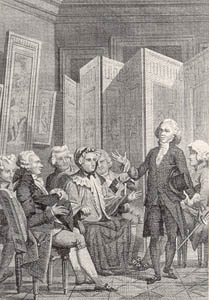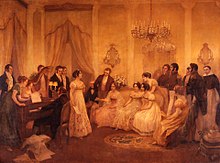沙龍 (聚會)
沙龍是由一個主人邀請其他客人參加,增加他們彼此交流的機會,或者得以愉悅自身及提升修養的聚會。沙龍最早出現於16世紀的意大利,在17至18世紀的法國中亦極為流行,直到現代仍然存在。

中式沙龍
目录
1 起源
2 歷史
2.1 時代劃分
2.2 內容和形式
2.3 公共領域
2.4 女性和沙龍
3 沙龍主人
4 法國以外的沙龍
5 參見
6 參考文獻
7 參考書目
8 擴展閱讀
9 外部連結
起源
沙龍(salon)一詞最早出現於1664年的法國(來自意大利語salone,這個意大利詞則來自sala,即意大利豪宅中的待客廳)。在這之前的文藝聚會通常也是以所用的房間來命名,例如內閣(cabinet)、陋室(réduit)和小巷(ruelle)等。[1] 在十七世紀末,這些聚會一般會在臥室中舉行(被看做是一種私人會客廳),[2] 通常情況是一位女士斜倚在床上,她的女友人們圍坐在四周的椅子上。不過像法王路易十四的petit lever中,客人全部都站著。小巷(ruelle)指床和墻之間的空間,這個詞一般來形容“矯揉造作的女子”的集會,這種集會出現在十七世紀上半葉受過教育的女子中。法國第一個著名沙龍是羅浮宮近處的朗布依埃府,其女主人朗布依埃侯爵夫人(1588-1665)從1607年開始一直舉辦沙龍直到去世。[3][4] 沙龍的很多規則也是由她一手製定的。
歷史

乔芙兰夫人的沙龍,1755年
沙龍的歷史十分複雜,因為這要涉及女權主義、馬克思主義及各種文化、社會歷史。從不同的角度可能會看到完全不同的景象,因此對於沙龍與法國歷史和啓蒙運動究竟有多大關係有很多見解。主流歷史編纂學觀點一般集中在沙龍與公共領域(諸如女性地位)的關係上。
時代劃分
沙龍的歷史劃分要看究竟採用哪種歷史編纂學觀點。一般意見是從十六世紀早期到十八世紀末為一個主要時期。德娜·古德曼認為其結束在法國大革命爆發時。[5] 史蒂文·凱爾的觀點較為獨特,他認為這段時期至少可以推遲到1848年革命之前。[6]
內容和形式
當時的文獻指出沙龍的主導理念是理想主義式的禮貌、優雅和誠實,但很可能實際情況並非如此。[7][8] 德娜·古德曼宣稱相對作為一個“禮儀學校”(schools of civilité)來說,沙龍更是一個哲學團體,因此才推動了啓蒙運動的發展。[9] 禮儀的重要性只是被放在第二位。[10]

沙龍的鼎盛年代被稱作“談話時代”(age of conversation)。[11] 沙龍中談論的主題分為談起來“禮貌”或“不禮貌”兩種,沙龍的主人也被認為需要擁有緩和氣氛的能力,不過所謂“禮貌”卻沒什麼正式定義。馬塞爾·普魯斯特認為政治是一定要避開的話題。[12] 但也有小部份人認為除了政府別的什麽都不應該談及。[13]
公共領域
尤爾根·哈貝馬斯的《公共領域的結構轉型》(1962年出版)是研究沙龍與公共領域的重要著作,該書的觀點是沙龍在歷史上佔有不可忽視的地位。[14] 他在定義“公共領域”時也把沙龍當做一個重要元素。[15][16]
在德娜·古德曼的《文學界》(The Republic of Letters)中,作者宣稱“公共領域就是由沙龍、新聞界和其他社交組織構成的”。[17] 該著作也進一步強調了沙龍在法國歷史和啓蒙運動中的重要性,這個觀點自從1994年《文學界》出版以來就一直佔據主流地位。[18] 不過也有人認為古德曼的著作“很顯然只是爲了支持(哈貝馬斯的)論文”,而不是去驗證它。[19]
相應的反對觀點來自諾博特·伊里亞思,他在《風俗史》(The History of Manners)一書中認為沙龍的的重要元素——禮貌、優雅和誠實,“都是些同義詞,不論廣義狹義,不過是一些人為自己的行為選定的標準”。[20] 瓊·蘭德斯(Joan Landes)也說“在某種程度上,沙龍只是制度化的宮廷的衍生物”,而不是公共領域的一部份。[21][22] 其他人,例如史蒂文·凱爾宣稱私人或公共領域的概念都與沙龍有重疊。[23][24]
女性和沙龍
沙龍和女性的關係也受到了歷史學家的關注。[25] 十九和二十世紀的很多著作一般都只談到沙龍和醜聞及“小陰謀”(petty intrigues)的關係。[26] 其他的一些則涉及到了沙龍中的女性的積極影響。[27] 不過也因為沙龍中女性過多使得其研究進展困難——當時的大多數重要人物都是男性。[28]
一些歷史學家試圖把目光放在單個的女性身上,不過直到1970年,這些歷史學家的著作大多都是關於這些沙龍主人的個人故事。[29] 在二十世紀末,隨著女權主義研究的進步,關於沙龍主人們的社會重要性的研究才逐漸多起來。[30] 關於啓蒙運動的一般性著作例如,《啓蒙運動在法國》(France in the Enlightenment)傾向於認為女性的統治地位只局限於沙龍內部。[31] 不過古德曼卻不這麼認為。[32] 她也曾說:“沙龍主人不是想擠到上流社會里,這些聰明的、受過教育的女子是通過吸收接納文學界的價值觀,並按自己的社會知識和教育需要將其用於塑造沙龍”。[33][34]
在吸引文人藝術家這一點上,沙龍不同於宮廷的是,它們並不用贊助來作為誘餌。另一個區別是其社會等級不太明顯。[35] 在十七十八世紀,“沙龍鼓勵異性間及貴族和布爾喬亞間的社交”。[36] 因此沙龍被認為促進了社會壁壘的消失。在十八世紀,沙龍進入了啓蒙運動的陣營。[37]
沙龍主人
沙龍主人一般都是些強勢的女性,她們是沙龍的核心,有權挑選客人、制定規則和沙龍主題。在沙龍中她們能夠得到自己想要的知識,並交換意見、給出評價,因此沙龍也被看做是這些女子對自己的繼續教育。[38] 十七世紀最著名的沙龍有1607年在朗布依埃府由其女主人朗布依埃侯爵夫人舉辦的沙龍,以及1652年史居里女勳爵舉辦的沙龍。
十八世紀著名的沙龍主人有:
- 乔芙兰夫人
- 唐森夫人
- 珍妮·奎納爾特
- 朱莉·德·雷斯毕纳斯
- 德芳侯爵夫人
- 蘭伯特侯爵夫人
- 緬因公爵夫人
- 德皮奈夫人
- 內克爾夫人
- 愛爾維修夫人
- 孔多塞夫人
- 羅蘭夫人
- 斯威特切尼夫人
法國以外的沙龍

瑪麗利基塔·桑切斯在布宜諾斯艾利斯的沙龍。

一個十九世紀中期的俄羅斯沙龍

季娜伊達·沃尔孔斯卡婭在莫斯科的沙龍
沙龍一度風靡歐洲,在十八到十九世紀,很多仿照巴黎式沙龍的沙龍出現在了歐洲各地,甚至包括一些新世界國家。
在十八世紀的英格蘭,最著名沙龍主人是伊莉莎白·蒙塔古,藍色長筒襪一詞就誕生自她的沙龍中,也是她本人成立了英格蘭藍色長筒襪協會。十九世紀為避1848年革命而躲到倫敦的俄羅斯梅里男爵夫人(Baroness Méry von Bruiningk)的沙龍也很有名。1860年代,女權主義者克萊門蒂亞·泰勒在倫敦也舉辦過激進的沙龍,參加她沙龍的人有[39]露意莎·奧爾柯特、[40]芭芭拉·博迪肯、莉蒂亞·貝克爾和伊莉莎白·布萊克威爾[41]。
在德國,沙龍主人包括一些猶太女性例如海利薇·赫茨和拉赫爾·瓦爾哈根,西班牙有第十三代阿爾巴女公爵(18世紀),希臘則有Alexandra Mavrokordatou(17世紀)。
16世紀的意大利藝妓圖利婭·達拉戈納舉辦過早期沙龍,其他人還有退位後的克里斯蒂娜女王和瑪麗·曼奇尼。19世紀時沙龍在意大利還再次興盛過一段時期,並在意大利歷史中佔據著一定的地位。當時爲了逃避政府審查,很多社會評論都是在沙龍中做出的。在這之後新聞界就取代了沙龍的位置。[42]
在伊比利亞半島或拉丁美洲,圖特利亞(tertulia)是一種類似沙龍的文藝聚會。這個詞最初來自西班牙語,20世紀的圖特利亞多舉辦在公眾場合,與會者會互相分享詩歌等藝術作品。[43]阿根廷的瑪利基塔·桑切斯是布宜諾斯艾利斯著名的沙龍主人。[44] 她熱心于革命,因此其圖特利亞聚集了當時幾乎所有的著名革命人物。1813年5月14日,阿根廷國歌祖國進行曲的首次歌唱就是在她的家中。[45]
在十七世紀的波蘭,斯尼亞夫斯卡女公爵曾舉辦過沙龍,十八世紀就更加普遍了,最著名的為十八世紀末的大公斯坦尼斯瓦夫二世的週四晚餐。
在斯堪的納維亞,沙龍由索菲亞·伊莉莎白·布倫納在十七世紀引入瑞典。十八世紀的沙龍主人有海德薇格·夏洛塔·诺登弗吕希特和安娜·瑪麗·倫格倫。十九世紀也有馬拉·西尔弗斯托尔佩。在丹麥,十八世紀末的克利斯蒂安·索菲·霍爾施泰因和夏洛特·西梅爾曼對該國政治也產生了一定影響。
參見
- 十七和十八世紀的英國咖啡館
- 巴黎沙龍
- 落選者沙龍
- 秋季沙龍
- 獨立者沙龍
- Salon.com
- 社交中心
- 雅集
參考文獻
^ (法文) Dictionaire des lettres françaises: le XVIIe siècle, revised edition by Patrick Dandrey, ed. Fayard, Paris, 1996, p. 1149. ISBN 2-253-05664-2
^ Aronson, Nicole, Madame de Rambouillet ou la magicienne de la Chambre bleue, Fayard, Paris, 1988.
^ Kale,Steven.French Salons : High Society and Political Sociability from the Old Regime to the revolution of 1848. Baltimore : The Johns Hopkins University Press, 2004. p.2
^ Lenotre, G. Le Château de Rambouillet, six siècles d'Histoire, Calmann-Lévy, Paris, 1930. New publication, Denoël, Paris, 1984, chapter: Les précieuses, pp. 20-21
^ Dena Goodman, The Republic of Letters: A Cultural History of the French Enlightenment (Ithaca: Cornell University Press, 1994), p. 280.
^ Steven Kale, French Salons: High Society and Political Sociability from the Old Regime to the Revolution of 1848 (Baltimore: Johns Hopkins University Press, 2006) p. 9
^ Sisley Huddleston, Bohemian, Literary and Social Life in Paris: Salons, Cafes, Studios (London: George G. Harrap, 1928)
^ Steven Kale, French Salons, p. 5.
^ Dena Goodman, 'Enlightenment Salons: The Convergence of Female and Philosophic Ambitions' Eighteenth-Century Studies, Vol. 22, No. 3, Special Issue: The French Revolution in Culture (Spring, 1989), pp. 330
^ Ibid., pp. 329-331
^ Benedetta Craveri, The Age of Conversation (New York: New York Review Books, 2005)
^ Kale, French Salons, p. 5.
^ Ibid., p. 5.
^ Jürgen Habermas (trans. Thomas Burger), The Structural Transformation of the Public Sphere: An Inquiry into a Category of Bourgeois Society (Camb., Mass.: MIT Press, 1989).
^ Ibid., p. 30.
^ Joan B. Landes, Women and the Public Sphere in the Age of the French Revolution (Ithaca: Cornell University Press, 1988); Goodman, The Republic of Letters; Erica Harth, Cartesian Women: Versions and Subversions of Rational Discourse in the Old Regime (Ithaca: Cornell University Press, 1992).
^ Dena Goodman, The Republic of Letters: a Cultural History of the French Enlightenment (Ithaca: Cornell University Press, 1994), p. 14.
^ Kale, French Salons, p. 238 n. 5.
^ Jolanta T. Pekacz, Conservative Tradition In Pre-Revolutionary France: Parisian Salon Women (New York: Peter Lang, 1999) p. 3.
^ Norbert Elias (Trans. Edmund Jephcott), The Civilising Process: The History of Manners, Vol. 1 (Oxford: Basil Blackwell, 1978), pp. 39-40.
^ Landes, Women and the Public Sphere in the Age of the French Revolution, pp. 23-5.
^ Landes, Women and the Public Sphere in the Age of the French Revolution, p. 23
^ Kale, French Salons, p. 12.
^ Antoine Lilti, ‘Sociabilité et mondanité: Les hommes de lettres dans les salons parisiens au XVIIIe siècle’ French Historical Studies, Vol. 28, No. 3 (Summer 2005), p. 417.
^ Jolanta T. Pekacz, Conservative Tradition In Pre-Revolutionary France: Parisian Salon Women, p. 1.
^ S. G. Tallentyre, Women of the Salons (New York: G. P. Putnam’s Sons, 1926) and Julia Kavanagh, Women in France during the Enlightenment Century, 2 Vols (New York: G. P. Putnam’s Sons, 1893).
^ Edmond et Jules Goncourt, La femme au dix-huitème siècle (Paris: Firmin Didot, 1862) and Paul Deschanel, Figures des femmes (Paris: Calmann-Lévy, 1900).
^ Pekacz, Conservative Tradition In Pre-Revolutionary France, p. 2.
^ Anny Latour (Trans. A. A. Dent), Uncrowned Queens: Reines Sans Couronne (London: J. M. Dent, 1970)
^ Carolyn C. Lougee, Women, Salons and Social Stratification in Seventeenth Century France, pp. 3-7.
^ Daniel Roche (Trans Arthur Goldhammr), France in the Enlightenment, (Cambridge, Mass.: HUP, 1998), pp. 443-8.
^ Goodman, The Republic of Letters, pp. 1-11.
^ Ibid., p. 76.
^ Pekacz, Conservative Tradition In Pre-Revolutionary France, p. 6; Lilti, ‘Sociabilité et mondanité, p. 2.
^ Goodman,Dena.Enlightenment salons: The Convergence of Female and Philosophic Ambitions. Eighteenth-Century Studies, Vol. 22. 3, Special issue : The French Revolution in Culture. ( Spring, 1989),p 338
^ Kale,Steven.French Salons : High Society and Political Sociability from the Old Regime to the revolution of 1848. Baltimore : The Johns Hopkins University Press,2004. p.2
^ Goodman,Dena.Enlightenment salons: The Convergence of Female and Philosophic Ambitions. Eighteenth-Century Studies, Vol. 22. 3, Special issue : The French Revolution in Culture. ( Spring, 1989),p.331
^ Bodek, Evelyn Gordon.Salonnières and the Bluestockings : Educated Obsolescence and Germinating feminism, Feminist Studies, Vol. 3 No. 3/4 ( spring-summer, 1976), p. 186
^ Moncure Daniel Conway. Autobiography Memories and Experiences of Moncure Daniel Conway. Volume 2. Elibron.com. June 2001: 14– [1 December 2012]. ISBN 978-1-4021-6692-1.
^ TayODNB.
^ MunODNB.
^ Romani, Gabriela. A room with a view: interpreting the Ottocento through the literary salon.. [16 April 2012].
^ El Madrid de 1900, espacios populares de Cultura y Ocio [Madrid in 1900, popular spaces for culture and leisure]; Tertulia Andaluza ("Tertulia Andaluza")
^ Soledad Vallejos. Recuperando a Mariquita. Perfil. July 16, 2004 [February 10, 2013].
^ Galasso, Norberto. Seamos libres y lo demás no importa nada [Let us be free and nothing else matters]. Buenos Aires: Colihue. 2000: 102. ISBN 978-950-581-779-5 (西班牙语).
參考書目
- Craveri, Benedetta, The Age of Conversation (New York: New York Review Books, 2005)
- Davetian, Benet, Civility: A Cultural History (University of Toronto Press, 2009)
- Elias, Norbert, (Trans. Edmund Jephcott), The Civilising Process: The History of Manners, Vol. 1 (Oxford: Basil Blackwell, 1978)
- Goodman, Dena, The Republic of Letters: A Cultural History of the French Enlightenment (Ithaca: Cornell University Press, 1994)
- Goodman,Dena, Enlightenment Salons: The Convergence of Female and Philosophic Ambitions, Eighteenth-Century Studies, Vol. 22, No. 3, Special Issue: The French Revolution in Culture (Spring, 1989), pp. 329–350
- Kale, Steven, French Salons: High Society and Political Sociability from the Old Regime to the Revolution of 1848 (Baltimore: Johns Hopkins University Press, 2006)
- Habermas, Jürgen, (trans. Thomas Burger), The Structural Transformation of the Public Sphere: An Inquiry into a Category of Bourgeois Society (Camb., Mass.: MIT Press, 1989)
- Harth, Erica, Cartesian Women: Versions and Subversions of Rational Discourse in the Old Regime (Ithaca: Cornell University Press, 1992).
- Huddleston, Sisley, Bohemian, Literary and Social Life in Paris: Salons, Cafes, Studios (London: George G. Harrap, 1928)
- Kavanagh, Julia, Women in France during the Enlightenment Century, 2 Vols (New York: G. P. Putnam’s Sons, 1893)
- Landes, Joan B., Women and the Public Sphere in the Age of the French Revolution (Ithaca: Cornell University Press, 1988);
- Latour, Anny (Trans. A. A. Dent), Uncrowned Queens: Reines Sans Couronne (London: J. M. Dent, 1970)
- Lougee, Carolyn C., Le Paradis des Femmes: Women, Salons and Social Stratification in Seventeenth Century France (Princeton: Princeton University Press, 1976)
- Lilti, Antoine, Sociabilité et mondanité: Les hommes de lettres dans les salons parisiens au XVIIIe siècle, French Historical Studies, Vol. 28, No. 3 (Summer 2005), p. 415-445
- Pekacz, Jolanta T., Conservative Tradition In Pre-Revolutionary France: Parisian Salon Women (New York: Peter Lang, 1999)
- Roche, Daniel, (Trans Arthur Goldhammr), France in the Enlightenment, (Cambridge, Mass.: HUP, 1998)
- Tallentyre, S. G., Women of the Salons (New York: G. P. Putnam’s Sons, 1926)
- Von der Heyden-Rynsch, Verena, Europaeische Salons. Hoehepunkte einer versunken weiblichen Kultur (Düsseldorf: Artemis & Winkler, 1997)
擴展閱讀
- Beasley, Faith E. Salons, History, and the Creation of Seventeenth-Century France. Hampshire: Ashgate Publishing Company,2006.
- Bilski, Emily et al. Jewish Women and Their Salons: The Power of Conversation, Jewish Museum New York, 2005.
- Craveri, Benedetta. The Age of Conversation. Trans.Teresa Waugh. New York: New York Review Books,2005.
- Benet Davetian "The History and Meaning of Salons"
James Ross, ‘Music in the French Salon’; in Caroline Potter and Richard Langham Smith (eds.), French Music Since Berlioz (Ashgate Press, 2006), pp. 91–115. ISBN 0-7546-0282-6.- Mainardi, Patricia. The End of the Salon: Art and the State of the Early Republic. New York: Cambridge University Press, 1993.
Hertz, Deborah. "Jewish High Society in Old Regime Berlin." New Haven and London: Yale University Press, 1988.
外部連結
| 查询維基詞典中的沙龍。 |
- 私人沙龍:
- Mlle de Scudéry
Les Contes de Fées: The Literary Fairy Tales of France: 17th-century Paris salons of Mme d'Aulnoy, the comtesse de Murat and others by Terri Windling.- Julie de Lespinasse, Mme Geoffrin in memoirs.
The Women of the French Salons by Amelia Ruth Gere Mason
Americans in Paris: Natalie Barney, Gertrude Stein, and Sylvia Beach. Three 20th century salons.- Charlottetown Conversation Salon
- Benet Davetian's Article on the History and Meaning of Salons
Biographies of French salonists from Madame de Rambouillet to Madame Recamier and descriptions of salon culture from the 17th to the 19th century.
The Genius Salon An active online salon.
- 藝術展覽:
Paris Salon of 1769: photos illustrate some of the paintings shown that year.
Comic art: The Paris Salon in Caricature: Getty Museum exhibition, 2003.
Jewish Women and Their Salons[永久失效連結]